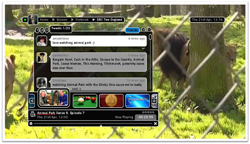Feature Stories - P2P comes to the rescue of Internet video
Video content is the fastest growing area of the Internet. Broadcasters are offering video-on-demand and live streams over the web, Internet service providers are rolling out their own IP-based TV services and Internet users themselves are uploading and sharing ever more videos via sites such as YouTube. According to some estimates, video equivalent to five years' worth of viewing time will stream across the internet every second by 2015, accounting for more than half the world's Internet traffic. Even with new technologies providing end-users with more bandwidth at lower cost, that's still a massive amount of data for networks to handle. 'The golden rule to remember is that all bandwidth available will be consumed,' says Jari Ahola, a project coordinator at the VTT Technical Research Centre of Finland. 'Just as bandwidth increases, the ways to consume it are increasing too: high definition video is one example.' The problem in large part is due to the way internet infrastructure is designed, based on servers sending data to each client. This so-called unicast model works well for viewing a website or transferring an email, but it is simply not efficient for distributing bandwidth-hungry video content to millions of people simultaneously. More problematic still is the fact that, unlike other types of data that can be broken down into packages and transferred in almost any order, video data must be streamed sequentially for the video to be watchable. But what if data could bypass servers entirely, hopping from one user to another? That, in essence, is what peer-to-peer (P2P) networks have long achieved. Though made famous by people using file-sharing applications to share pirated content, P2P technology has a wide range of legitimate uses, not least, in the view of Mr Ahola and others, potentially saving the Internet from video-induced congestion. Working in the P2P-Next(opens in new window) (1) project, Mr Ahola coordinated a consortium of 20 industrial partners, media content providers and research institutions in developing of an innovative open source P2P video delivery platform called NextShare. Supported by EUR 14 million in funding from the European Commission, the team designed, implemented and successfully tested algorithms and protocols to use P2P architecture to stream video. 'The key difference with P2P applications for file sharing is that video data can't be broken into different packets and sent in any order, it has to be sent in sequence and maintain a certain level of quality of service,' Mr Ahola explains. Beyond BitTorrent The P2P-Next team initially based their system on the widely used and proven BitTorrent protocol, adapting it to handle video streams, whether video-on-demand, live webcam feeds or TV channels. Building on that research, they then developed their own open source protocol called Swift, which has been presented as a new P2P video sharing standard. To test their technology, the team built a web-browser plug-in called Swarmplayer allowing Internet users to access Internet video via the Firefox browser, with each user acting as both a client and a server - peers - for other users. In collaboration with project partner Pioneer Digital Design, they also developed a set-top-box to show how simply and cost-effectively the system can be incorporated into consumer electronics devices. 'The set-top-box is a low-cost device that gives users access to P2P distributed video streams on their TV via their Internet connection. It also has social networking features so, for example, users can view Twitter comment feeds about what they are watching as they watch it - something that is likely to become increasingly popular in the future,' the P2P-Next coordinator explains. The researchers validated the system in several trials, the largest of which was conducted at the University of Lancaster in the United Kingdom, looking not just at the bandwidth savings versus other technologies, but also video quality and stability. They also showcased their set-top-box and the underlying technology at several conferences and events, including IBC 2011 in the Netherlands, where they streamed a live BBC broadcast from London using the system. 'The feedback from test users and others who have seen it in action has been very positive, most thought it was at least as good as a traditional video stream,' Mr Ahola says. More significantly, the team found that the P2P approach slashes bandwidth demands by a minimum of 65% compared to the unicast streaming approach. It is also less demanding than multicasting - another approach to distributing video content whereby one data stream is distributed to many local servers that subsequently rebroadcast the content to local users. However, most current IP routers do not support multicasting and implementing it widely would be costly. 'For network operators, P2P offers a big advantage in terms of bandwidth demands and cost. Content providers are also interested in this technology as a low-cost alternative for their content delivery networks,' the P2P-Next coordinator says. Providers such as the BBC and IRT/EBU were partners in the P2P-Next initiative and may look to develop commercial systems based on the technology. Meanwhile, Bitnomica, a Dutch IT spinoff from Delft University of Technology in the Netherlands, another project partner, has started to market a P2P platform based on the Swift protocol. The technology is well matched to a content delivery environment in which the old unidirectional broadcast model is being replaced by a user-centric, time and place independent model as people demand the ability to view, generate and share content whenever and wherever they like, using a range of heterogeneous devices. 'By developing these open source protocols and algorithms, we've laid the groundwork for others to follow and develop their own applications. I would not be surprised to see P2P video streaming becoming much more widespread in the future,' Mr Ahola explains. P2P-Next received research funding under the European Union's Seventh Framework Programme (FP7). 1 'Next generation peer-to-peer content delivery platform'. Useful links: - 'Next generation peer-to-peer content delivery platform' website(opens in new window) - P2P-Next project factsheet on CORDIS(opens in new window)



